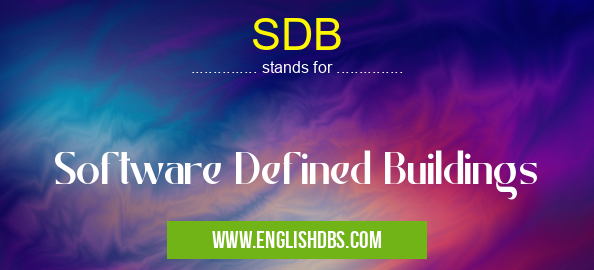What does SDB mean in SOFTWARE
Software-defined buildings (SDB) is a term used to describe the integration of software into the functional components of a physical building. This approach, which has become increasingly popular in recent years, uses IoT and other digital technologies to create a more intelligent and efficient building environment. By using sensors and data analytics, SDB solutions enable better efficiency in lighting, heating, ventilation – even security systems. In short, SDB reduces energy costs and makes it easier to manage all aspects of an environment from one central platform

SDB meaning in Software in Computing
SDB mostly used in an acronym Software in Category Computing that means Software Defined Buildings
Shorthand: SDB,
Full Form: Software Defined Buildings
For more information of "Software Defined Buildings", see the section below.
What is SDB?
Software Defined Buildings are systems that use smart technologies like the Internet of Things (IoT) to integrate all the different elements within a physical space. It allows individuals or enterprises to control those components remotely with software-based controllers over wireless networks. These controllers can monitor temperature levels, motion detection, lighting levels and even security systems like access controls or cameras for safety purposes
Essential Questions and Answers on Software Defined Buildings in "COMPUTING»SOFTWARE"
What is Software Defined Buildings?
Software Defined Buildings (SDB) is a technology that enables building owners and operators to manage the energy use of their buildings through software. This allows them to reduce energy costs, improve operational efficiency, and increase building occupant comfort and satisfaction.
What are the benefits of using SDB?
By using SDB, building owners can realize a variety of benefits such as lowered utility bills, reduced operational costs, improved energy efficiency, enhanced safety and security measures, and improved occupant comfort.
How does SDB work?
SDB works by connecting various digital systems in your building to each other while also providing remote access to those systems. This allows for greater control over the energy use of the building in order to reduce costs and increase efficiency.
What are some common examples of SDB solutions?
Common examples of SDB solutions include smart thermostats which allow for remote temperature control; automated lighting systems which adjust the brightness according to occupancy levels; occupancy sensors which detect motion within a room; solar panel monitoring systems which track electricity production from renewable sources; and HVAC systems that monitor air quality for maximum indoor comfort.
Is an SDB system difficult or expensive to install?
The cost and complexity of installing an SDB system varies widely depending on the size of the building and its existing infrastructure. That said, most systems are relatively simple to install and require minimal disruption to existing operations. Additionally, many service providers offer turnkey solutions that make installation quick and easy.
How long will it take for an SDB system to pay off?
The return on investment from an SDB system depends on a variety factors such as size of the building, energy usage patterns, available incentives, etc. Generally speaking though most buildings will begin seeing cost savings within months after installation. Over time these savings can accumulate into significant annual savings on operating expenses.
Are there any additional benefits besides financial ones?
Yes! By reducing energy consumption with an SDB system a building can also reduce its environmental impact by minimizing carbon emissions associated with its operations. Additionally occupants may find their space more comfortable due to improved HVAC controls and higher quality air filtration systems.
Are there any restrictions/limitations when installing an SDB system?
Installation requirements often vary depending on local regulations so be sure you consult with your local authorities prior to installation. Additionally some areas may have restrictions on certain types of technologies (e.g., drones). Lastly depending on where you live there may be other limitations such as limited access or unreliable internet connections.
Is it possible for me to configure my own custom settings for my buildings' needs with an SDB system?
Yes! Most modern software defined buildings solutions provide users with tools that enable them customize settings according to their specific needs - whether it be adjustable temperature or humidity levels or scheduling lighting/air conditioning operations - all without needing any special technical knowledge.
SDB also stands for: |
|
| All stands for SDB |
